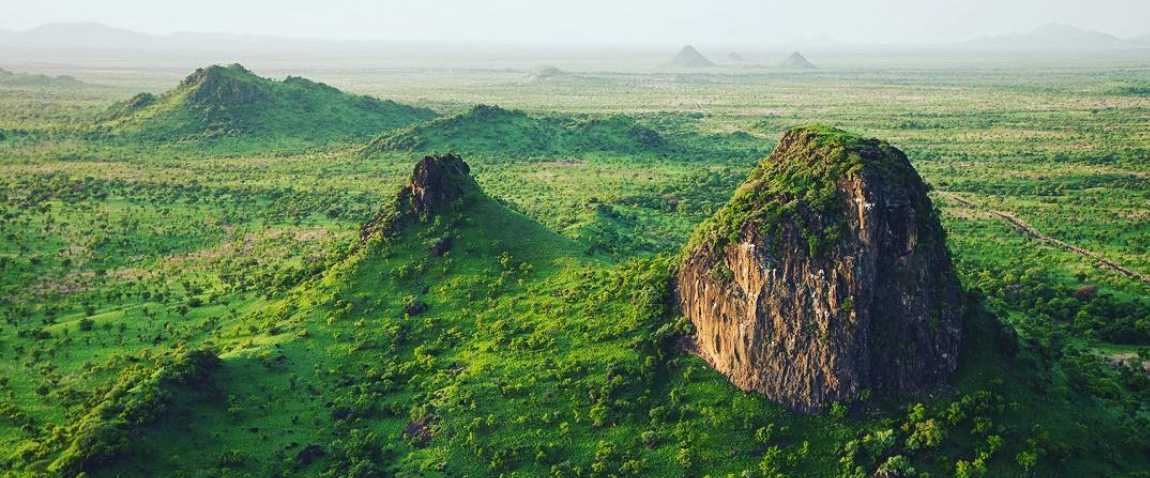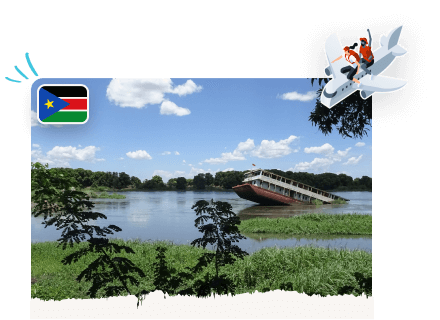
Do you know such a city as Juba? Where is Juba situated? Juba is the capital and the largest city of South Sudan. This city is located on the banks of the White Nile; it is also the capital of the Central Equatoria state. In the east, South Sudan itself is bordered by Ethiopia, Uganda, and Kenya. South Sudan, where is Juba located, shares the southern borders with the Democratic Republic of the Congo and the northern borders with Sudan. To the west, South Sudan borders the Central African Republic. The country has no outlet to the sea.
What about the Juba weather? Is Juba weather too hot? The climate in South Sudan overall is subequatorial, so in Juba. It's humid enough here. The thermometer rises to + 35 ... + 38 ° C and fluctuates slightly throughout the year. Only during the dry season, the temperature drops significantly at night. The drought period lasts from November to March. Up to 700 mm of precipitation falls per year in the north and up to 1400 mm in the southwest. In the south of the country, there is another dry season in June-July. The best time for visiting Juba is from late July to October.
It is not so popular among tourists to travel to Juba; however, it is one of the places which you need to visit at least once in your life. You can have an unforgettable time in Juba! There are many beautiful and Instagrammable places in Juba, where you can get most-liked photo on Instagram. Therefore, you will have not only a wonderful time in Juba but also a nice feed on Instagram.
In this blog, we will share the 12 Instagrammable places in Juba.
1. Boma National Park

Copyright: @afrikadayasha
It is a protected area in eastern South Sudan near the Ethiopian border, established in 1986. The national park covers 22,800 square kilometers (8,800 sq mi) of fields and floodplains, and it is an essential refuge for white-eared cobs, Corrigum, and Mongalla's gazelle. Other large mammals are buffaloes, elephants, leopards, giraffes, zebras, oryxes, bubals, and cheetahs. It is also an important bird habitat: the avifauna includes the Rappell Vulture (Vulture) and the Black-breasted Snake Eagle. The neighboring Gambela National Park in Ethiopia protects similar species.
The most notable species in Boma National Park is the white-eared kob (Kobus kob leucotis). A UNEP study reports that the white-eared cob is found mainly in the east of the Nile River in South Sudan in clay plains and wetlands.
2. Bandingilo National Park

Copyright: @hannahvandijck_wildlife
Bandingilo National Park, sometimes called Badingilo, is located in South Sudan, within the states of Central Equatoria and Eastern Equatoria. It was founded in 1992. Located in a wooded area near the White Nile River, it covers over 10,000 square kilometers (3,900 sq mi).
This is the second-largest annual migration of animals (the most massive migration of the Serengeti), including several antelope species, including the marsh goat, white-eared cob, and the reserve also home to the iconic African megafauna like the giraffe. It also contains extensive swamps extending into Jonglei State. The park supports numerous bird populations. You can take in this national park's most liked photo on Instagram and enjoy the wild nature.
On July 6, 2011, three days before South Sudan formally seceded from Sudan, and the Administrative Headquarters was officially inaugurated at a ceremony led by Central Equatorial Governor Clement Wani and USAID Director of Sudan William Hammink.
3. The Imatuna Mountains

Copyright: @bomahills
The Imatuna Mountains (also Immatun, or rarely Mathon) are located in the Eastern Equatoria State in southeastern South Sudan and extend into the Northern Region of Uganda.
Mount Kinjeti is the tallest mountain at 3,187 meters (10,456 feet) and the highest point in South Sudan, where is Juba situated. The range has an equatorial climate and dense, mountainous forests supporting diverse wildlife. Since the mid-20th century, the rich ecology has been increasingly degraded by forestry and subsistence farming, causing the slopes' extensive erosion.
4. Main Mosques
At the Main Mosque, you can enjoy the remains of the once-bewitching and functional Islamic place. Although it's currently under restoration, you can still look at turquoise walls and the tall terracotta minaret.
5. All Saints Cathedral

Copyright: @thebeikalafeng
All Saints Cathedral is a tiny religious site located in a small park in Juba, surrounded by tall trees that offer pleasant shade on hot days. You can see the moderate though architecturally charming cathedral, which emphasizes dual well-formed brick towers and gate decorations of rust-colored and white mosaics covered by a vast white mixture. On Sundays, you can visit the section in English.
6. St. Theresa Cathedral
Travel to St.Theresa Cathedral because it is the capital's most eminent and valued spiritual site. Although not old, this church, constructed in 1952. Cathedral's reasonable history share was observed and used as a shelter for over 5,000 people during the civil war in Sudan. Now, it serves as the archbishop's place. Take a tour around this charming building, showcasing simple but admirable architecture, and take heed to the clock tower on the right side of St. Theresa Cathedral.
7. St. Joseph's Catholic Church
It is a little, but the neat and well-maintained religious place in Juba. On Sundays, town priests hold various masses in several languages due to the multiculturalism of Juba. A visit to one of these places to reach many amiable locals and get a bit about their life.
Jebel Kujar hill
If you're an energetic person, you can hike up to Jebel Kujar hill. It will take roughly 25 minutes to reach the top and enjoy plenty of great views on the way. When you reach the top, you'll have a breathtaking view of the city below. This hill is highly Instagrammable and opens for you a stunning landscape.
8. Banks of the Nile

The Nile banks are the greenest places in Juba. You can have a view of them from the Nile Bridge and taking a boat along the river, and you can get even closer to the nature of Juba. Some trips cover the food and drink, and you can also stop off in one of the places in which it is safe to swim.
9. Nyakuron Cultural Center

Copyright: @noorlehumon
The culture of South Africa is quite diverse, and the best place to enjoy is in Juba, precisely at the Nyakuron Cultural Center. This center is one of the most Instagrammable places in Juba. Constructed in 1976, it is a vast complex that includes an open-air stage, a nightclub, an auditorium, and extensive gardens - its main fascination. However, there are also cultural shows and festivals.
10. Juba Bridge

Copyright: @jigar_jit_patel
Additionally, related to the Juba Nile Bridge, it is the single bridge that goes across the Nile in all of South Sudan and pends the New Freedom Bridge's completion. With 252 meters long, the Juba Bridge was created in 1972 during the General Gaafa Al-Nimery regime from two World War II bridges. The bridge was restored extensively in 2011 after going through some damage. Currently, it is also an essential way for the transportation of precious goods from neighboring countries. Juba Bridge is very Instagrammable, and you can get the most liked photo on Instagram there.
11. John Garang Mausoleum

Copyright: @samirbol
The unusual mausoleum is the last resting spot of Dr John Garang de Mabior, the father of South Sudan. He was a chief protagonist in the battle for South Sudan's Independence, commencing the Sudan People's Liberation Movement (SPLR) between 1983 and 2005 when the peace accords for the country's independence was signed. He died after independence, and the mausoleum was set up in his account. The original grave is locked behind a gate and heavily guarded - the mausoleum remains a core place for the city, frequently being a venue for different public events.
And now, one small surprise for you! If you want to travel to Juba, you need to know what food you should taste. So, here, five types of food, which we recommend you when traveling to Juba.
- Local pastries are tasty, high quality, and safe. These pastries are not only delicious but also Instagrammable.
- African tea is noteworthy that this drink is sometimes called coffee, although it is a delightful tea with milk and spices. In the most popular cafes, it is usually pre-brewed in a large plastic thermos.
- The local food consists of rice, beans, banana stew.
- Chinese or Indian food is just for the sake of curiosity. Juba already has several establishments of international cuisine, opened by visitors.
- Cold drinks. If you drink alcohol, try South Sudanese brands, for example, White Bull. Of course, it is not at all a fact that it is brewed in South Sudan (and even most likely it is brought in), but the advertisement says that this beer has a taste of independence and progress!
We wish you have a wonderful time in Juba!


